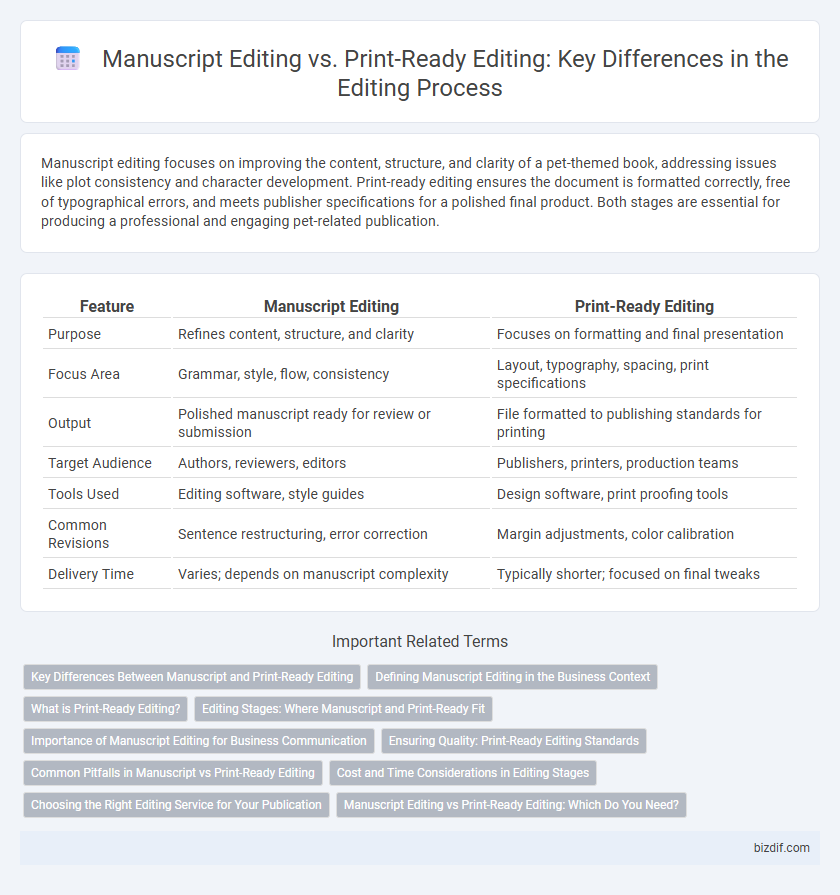Manuscript editing focuses on improving the content, structure, and clarity of a pet-themed book, addressing issues like plot consistency and character development. Print-ready editing ensures the document is formatted correctly, free of typographical errors, and meets publisher specifications for a polished final product. Both stages are essential for producing a professional and engaging pet-related publication.
Table of Comparison
| Feature | Manuscript Editing | Print-Ready Editing |
|---|---|---|
| Purpose | Refines content, structure, and clarity | Focuses on formatting and final presentation |
| Focus Area | Grammar, style, flow, consistency | Layout, typography, spacing, print specifications |
| Output | Polished manuscript ready for review or submission | File formatted to publishing standards for printing |
| Target Audience | Authors, reviewers, editors | Publishers, printers, production teams |
| Tools Used | Editing software, style guides | Design software, print proofing tools |
| Common Revisions | Sentence restructuring, error correction | Margin adjustments, color calibration |
| Delivery Time | Varies; depends on manuscript complexity | Typically shorter; focused on final tweaks |
Key Differences Between Manuscript and Print-Ready Editing
Manuscript editing focuses on improving the structure, clarity, and content flow, targeting issues like grammar, style, and consistency to enhance readability. Print-ready editing involves finalizing the document for publication, addressing formatting, typesetting, and ensuring adherence to printing specifications. The key difference lies in manuscript editing's goal of refining the author's message versus print-ready editing's emphasis on preparing the document's physical presentation.
Defining Manuscript Editing in the Business Context
Manuscript editing in the business context involves refining the structure, clarity, and coherence of a document to ensure it effectively communicates its core message to the target audience. This process includes correcting grammar, enhancing tone, and ensuring consistency, which elevates the professionalism and readability of reports, proposals, or marketing materials. Unlike print-ready editing, manuscript editing focuses on content development and strategic communication rather than final formatting and layout adjustments.
What is Print-Ready Editing?
Print-ready editing ensures a manuscript meets all technical standards for publication, including layout accuracy, formatting consistency, image resolution, and final proofreading. This type of editing goes beyond basic grammar and style checks, focusing on preparing the document for seamless printing or digital distribution. Print-ready editing minimizes production errors and enhances the visual presentation of the final product.
Editing Stages: Where Manuscript and Print-Ready Fit
Manuscript editing primarily occurs during the developmental and content revision stages, focusing on structure, clarity, and coherence to enhance the overall narrative. Print-ready editing is the final stage, emphasizing copyediting, proofreading, and formatting to ensure the manuscript meets publication standards. Understanding these distinct editing stages helps authors strategically allocate resources for a polished and professional final product.
Importance of Manuscript Editing for Business Communication
Manuscript editing ensures clarity, coherence, and professionalism in business communication, enhancing the message's impact on clients and stakeholders. It refines grammar, tone, and structure to maintain brand credibility and avoid misinterpretation or confusion. Effective manuscript editing is crucial for producing polished documents that drive successful business outcomes before advancing to print-ready editing.
Ensuring Quality: Print-Ready Editing Standards
Print-ready editing demands strict adherence to formatting, grammar, and typographical standards to guarantee a flawless final product. It involves precise layout adjustments, resolution checks, and prepress compatibility to meet publishing requirements. Ensuring quality at this stage prevents costly printing errors and enhances the manuscript's professional presentation.
Common Pitfalls in Manuscript vs Print-Ready Editing
Manuscript editing often struggles with inconsistent formatting and unclear narrative flow, which can obscure the author's intended message. Print-ready editing requires meticulous attention to typographical errors and layout issues, as failing to address these can lead to costly printing errors and reduced readability. Overlooking these distinct challenges between manuscript and print-ready stages can result in delays and increased production costs.
Cost and Time Considerations in Editing Stages
Manuscript editing typically involves comprehensive content revision and can be more time-consuming and costly due to extensive structural and stylistic changes. Print-ready editing focuses on final polishing, including formatting and error correction, generally requiring less time and lower costs compared to manuscript editing. Budgeting for editing stages should consider the scope of work, with manuscript editing demanding higher investment in both cost and time to ensure a well-developed draft before moving to print-ready preparation.
Choosing the Right Editing Service for Your Publication
Manuscript editing focuses on improving the structure, clarity, and coherence of your writing, addressing grammar, style, and flow to prepare your document for initial submission. Print-ready editing ensures the final formatted version is polished, error-free, and adheres to publication standards, including layout, typography, and citation consistency. Selecting the right editing service depends on your publication stage and goals, with manuscript editing ideal for early drafts and print-ready editing necessary before distribution or printing.
Manuscript Editing vs Print-Ready Editing: Which Do You Need?
Manuscript editing focuses on improving content, structure, grammar, and coherence to prepare a draft for submission or peer review, whereas print-ready editing involves formatting, typesetting, and final proofing to ensure the document meets publishing standards. Choosing between manuscript editing and print-ready editing depends on your project's stage and specific goals, such as enhancing readability or preparing for professional printing. Identifying your needs early saves time and ensures a polished final product tailored to your target audience.
Manuscript Editing vs Print-Ready Editing Infographic

 bizdif.com
bizdif.com